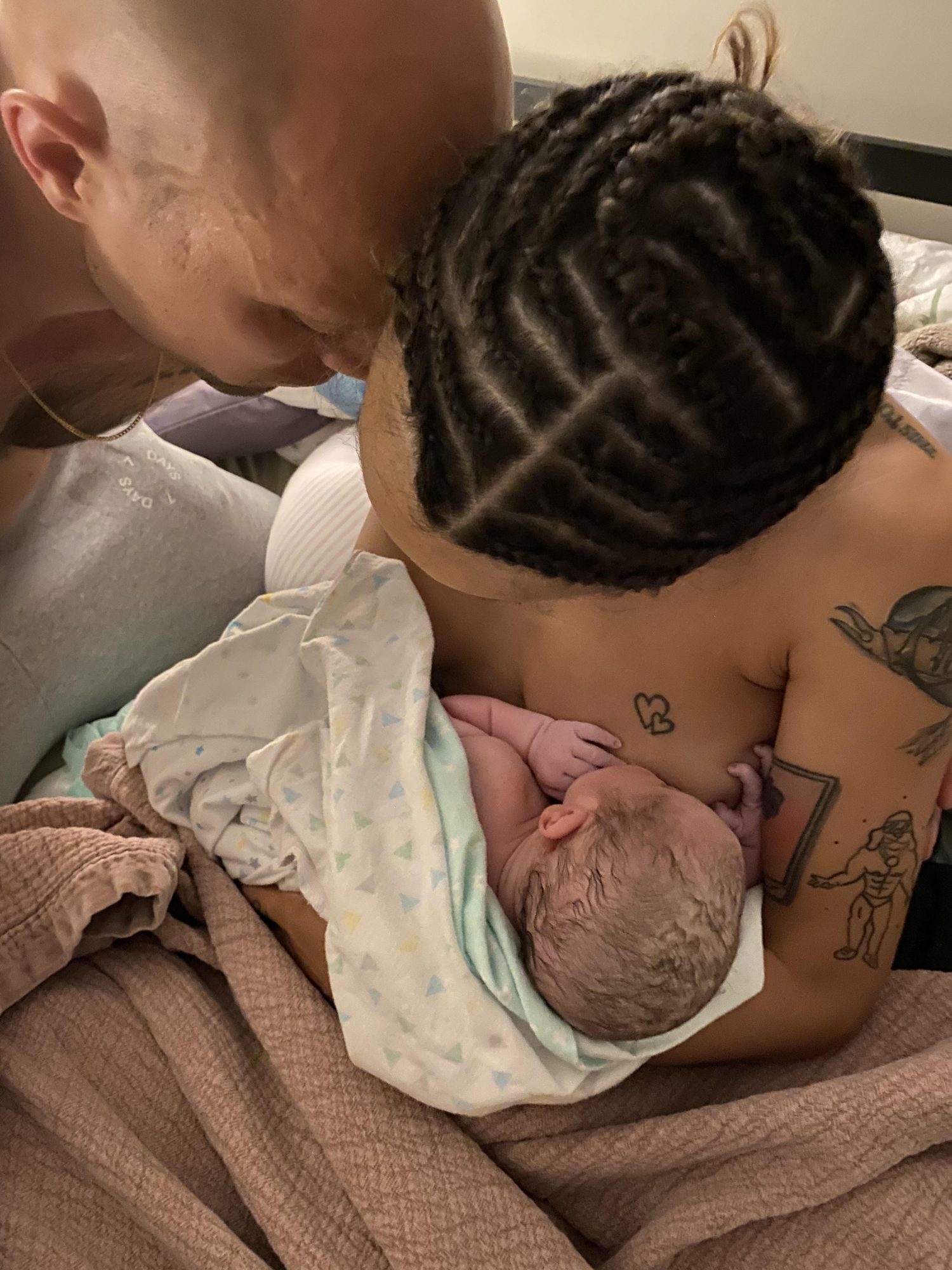
Model and recording artist Marz Lovejoy gave birth to her second child during the coronavirus pandemic at her mother's home in St. Paul, Minnesota where generations of Black women were raised before her. Attended by her doula, midwife, and a birthing assistant—all wearing PPE masks—and her husband, her labor was recorded on live-stream to raise money to fund childbirth services for Black, POC, and LGBTQ people. The live-feed ended shortly after her baby made his first cries. “Me too, baby,” she responded as she held her new baby boy to her chest.
While Lovejoy planned to have a home birth well before the coronavirus pandemic began, COVID-19 has given rise to a new interest in non-hospital births for many pregnant people. The primary reason? Concern over entering a hospital amongst COVID-19 patients and potentially exposing themselves and their newborn to the virus. With COVID-19 patients overwhelming hospitals and changes to visitation policies in the delivery room, the idea of giving birth in your own home, surrounded by people in "your circle" has become more appealing for many.
Currently, the American Academy of Pediatrics (AAP) does not recommend planned home birth. The AAP states that current data shows hospitals and accredited birth centers are the safest settings for birth in the United States. A study on home births in Canada, however, concluded home births to be just as safe as hospital births. The difference in these conclusions? Researchers found that when home births and midwives are integrated into the health care system, as they are in Canada, outcomes for both mom and baby are better during home births. Such integration hasn’t happened yet in the United States (many midwives are not recognized by the states they operate in) and there’s currently no federal regulation of midwives, but birthing people in the U.S. are clearly calling for this to change.

Recognizing the Critical Need for Birthing Options
Lovejoy’s experience being a Black woman and not being listened to by doctors made her an advocate for birthing options, specifically home birth. “I know that other women have experienced this, and I want them to know that this is an option that can ultimately change the trajectory of their birthing experience,” she says.
For Black and Indigenous women, birth is a risky endeavor. Black women are three times more likely than white women to die from pregnancy and childbirth-related complications. Native American and Alaska Native women are at twice the risk of death compared to white women. Overall, America’s birth statistics are ghastly. Compared to women in other similarly wealthy countries, like Germany, Canada, or Australia, American women are more likely to experience maternal death. In America, giving birth in a hospital is considered the default. By contrast, according to a report by the World Health Organization, many European countries have made it a policy goal to provide pregnant women with a choice of where they'll give birth.
Abigail Echo-Hawk, member of the Pawnee Nation of Oklahoma, chief research officer at the Seattle Indian Health Board, and director of the Urban Indian Health Institute, says ensuring birthing people have options instead of a one-size-fits-all maternal health care system is a key part of the solution to addressing these disparities. “It is very important to respect a woman's choice on what she would like to do in or her birthing plan,” she says. “If she wants to have a midwife, she should be able to access a midwife.”
Replacing Stigma with Support
The choice of whether to give birth in a hospital, birthing center, or at home, is an informed choice that a woman should be able to make herself, she says. Unfortunately, there’s a pervasive stigma in the United States that characterizes women who choose home birth as irresponsible.
The stigma is from a variety of assumptions and the lack of experience most people have with home births, explains Tanya Wills, LM, CNM, WHNP-BC, licensed midwife and certified nurse practitioner. “Where birth is concerned, this stems from the fact that most people become pregnant knowing precious little about birth and their reproductive bodies, and so they turn to a more paternalistic model,” she says. “So someone will tell them how to have the baby. But the more people are talking about birth, the more information is out there about the truth, the more progress we make.” Wills attends home births as the co-owner of Small Things Grow Midwifery and says despite the stigma and fear of the unknown, her home birth outcomes are excellent.
The American College of Obstetrics and Gynecologists (ACOG), published a report in 2017 that stated although planned home birth is associated with fewer maternal interventions than planned hospital birth, it is associated with a more than twofold increased risk of perinatal death (1–2 in 1,000) and a threefold increased risk of neonatal seizures or serious neurologic dysfunction (0.4–0.6 in 1,000).
However, a 2019 study in The Lancet's EClinicalMedicine journal analyzed approximately 500,000 intended home births of women with low-risk pregnancies and found that the risk of perinatal or neonatal mortality was not higher for women who gave birth at home compared to at a hospital. The study is also one among many reporting that childbirth interventions, such as cesarean sections and inductions, are significantly reduced when women give birth at home.

Prioritizing Both Safety and Security
Sirina Keesara, M.D., an OB-GYN at West Oakland Health Center and research fellow at the Stanford University Clinical Excellence Research Center, said it's a low-intervention approach, specifically the midwifery care model, that can improve childbirth outcomes and experiences for birthing people. “The midwifery model of care helps to improve outcomes in terms of avoiding C-sections and too much interference in a very normal process, specifically in women of color,” she says. Currently, about one-third of babies born in the U.S. are delivered via C-section. According to the March of Dimes, C-section rates for Black women are the highest. Though C-sections can be lifesaving for both mom and baby when they are medically necessary, many are not—and they come with greater risk of blood loss, infection, blood clots, or risk of death than vaginal birth.
Birth centers are another out-of-hospital option for expectant mothers. Dr. Keesara notes that birth centers have been shown to reduce preterm birth, a leading cause of neonatal death, for women of color. “People are much more aware that maternal mortality is more likely to affect Black women, and women feel it in the hospital,” she says. “They feel unsafe there. They don't feel like they have an advocate. People need to feel safe in the place they are delivering.” For many women, like Lovejoy, that safe place might be home. For others, it might be the comfort of birthing centers with a supportive staff and a low-intervention approach that’s proven to benefit women.
Putting the Focus on the Future of Prenatal Care
The Strong Start for Mothers and Newborns Initiative by the Centers for Medicare and Medicaid Services tested approaches to maternal health care that focus on the medical and psychosocial factors of pregnant women in order to reduce early elective deliveries and enhance prenatal care. According to a 2019 article in Birth Issues in Perinatal Care, in this five-year project, birth centers partnered with researchers to provide care that addressed the social determinants of health, such as race and income, to reduce health disparities and lower risk of maternal and neonatal death and injury. The results were just that, and the report notes that birth centers and midwifery-led prenatal care are a part of the solution to the maternal mortality crisis in America.
Dr. Keesara says interest in birthing center care was on the rise even before the coronavirus pandemic. The negative attitudes toward out-of-hospital births, however, have persisted despite research pointing to the need to expand such options. Instead of dismissing hospital alternatives for childbirth, it’s time to start looking at who is a good candidate for non-hospital options and how we can then make those options most accessible.
Parents.com investigates the nation’s maternal health crisis and what can be done to lower the risk for thousands of expecting mothers. Read more here.





